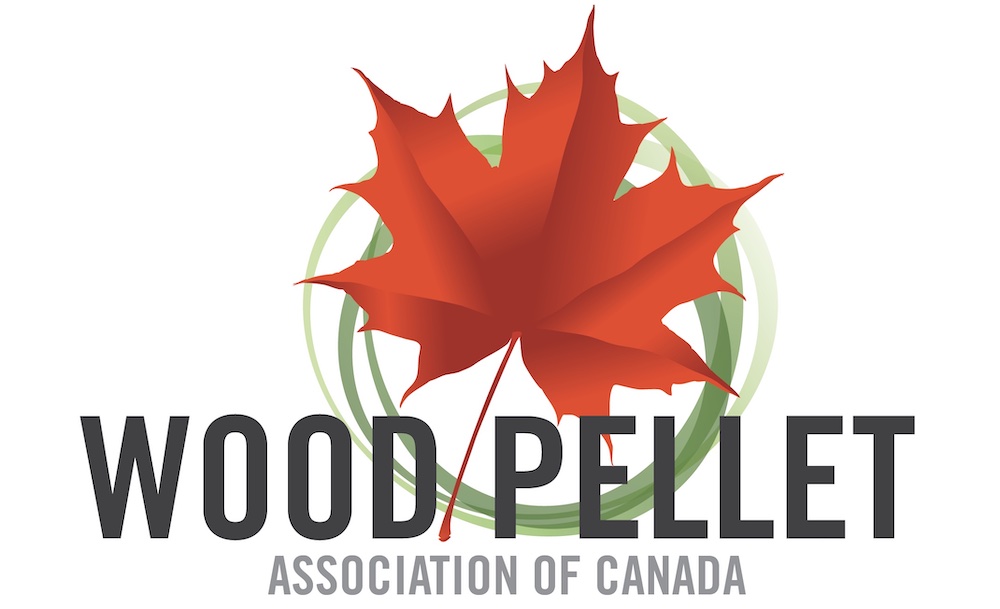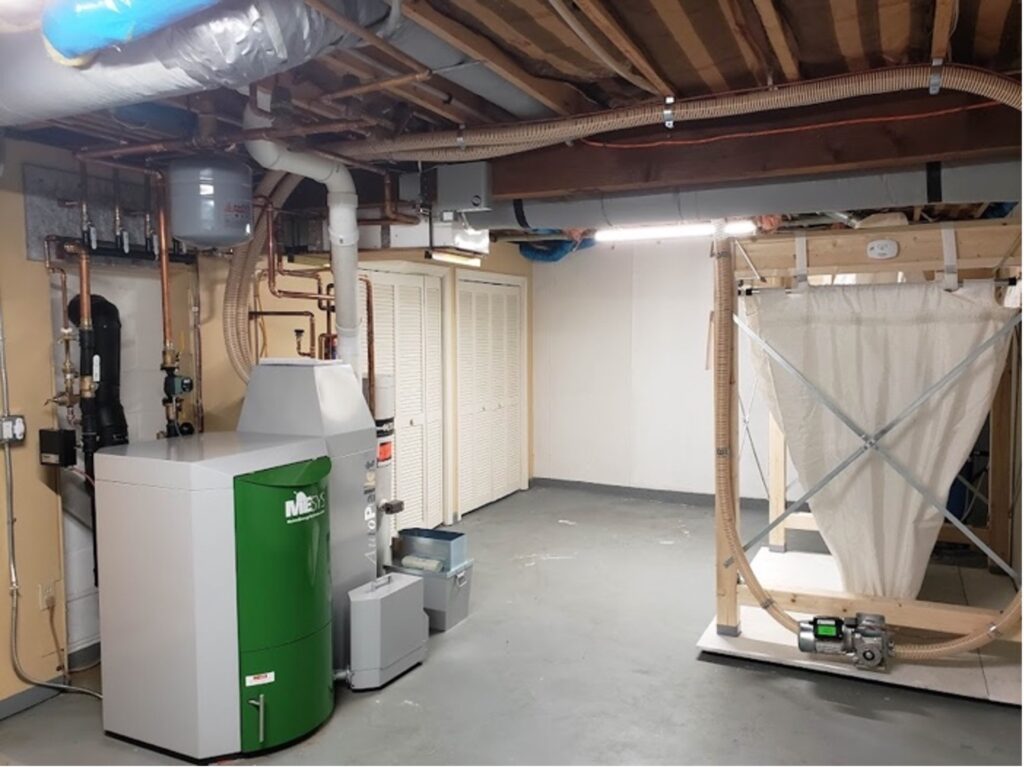
New white paper accelerates the shift to bioheat in Canada
May 10, 2023
By Harry “Dutch” Dresser and Gordon Murray
Sponsored
Harry “Dutch” Dresser and Gordon Murray explain how a new white paper addresses barriers that currently restrict the sale of small solid biomass combustors into the Canadian market.
 SSBC certified to EU standards come in many sizes and shapes. This one is a condensing boiler with an efficiency of about 94 per cent using the higher heating value of fuel. Photo credit: MESys.
SSBC certified to EU standards come in many sizes and shapes. This one is a condensing boiler with an efficiency of about 94 per cent using the higher heating value of fuel. Photo credit: MESys. A new white paper has been released that sets the stage for the creation of a new national standard to allow for the import or export (two-way trade) of European certified small solid biomass combustors into Canada; thereby removing existing barriers and paving the way for Canadians to replace fossil fuels with the renewable and clean energy that wood pellets provide.
The white paper, titled Certification of Small Solid Biomass Combustors (SSBC) in Canada, was commissioned by the Provincial-Territorial Advisory Committee (PTAC) which looks at standardization issues. The paper is the culmination of nearly five years of work by experts across the country to address barriers that restrict the sale of SSBC systems that use wood pellets into the Canadian market.
At the heart of the issue
The issue lies in the fact that Canadian regulatory authorities require SSBC to be manufactured according to the Canadian Standards Association’s CSA B51 boiler, pressure vessel, and pressure piping code. B51 references ASME’s (American Society of Mechanical Engineers) boiler and pressure vessel code. CSA B51 and ASME, while safe, are incompatible with the safety certification procedures used by European-manufactured SSBC.
Currently Austria and Germany produce the most advanced and among the safest boiler systems in the world. These SSBC are manufactured according to the European EN 303-5 boiler safety standard (SSBC up to 500kW output power) as well as relevant provisions of European pressure equipment and machinery directives. These standards are safe, effective, and are recognized in some countries outside Europe, but not in Canada.
To sell these SSBC in Canada, the pressure vessels must be redesigned to ASME specifications and remanufactured using ASME-specified materials in ASME-certified factories. Given the small size of the developing SSBC marketplace in Canada, compliance with such requirements costs producers more to build the product; a cost they must pass onto the Canadian end-user. As a result, the availability of these products for Canadians is limited to a few models of premium brands that are remanufactured and then sold at premium prices.
The simple fact is that there have been no safety issues with these SSBC systems currently being used in places like Austria where 137,000 SSBC have been installed. The same holds true for Prince Edward Island which has allowed the use of SSBCs built to the EU standard in schools, hospitals and greenhouses for the past decade.
Long-time trade irritant
Stakeholders in both Canada and Europe, including the European Commission, through Global Affairs Canada (GAC) and the Standards Council of Canada have asked Canada to allow the import of small solid biomass combustors built to the EU standard. This would support the Regulatory Cooperation Forum (RCF) as outlined in the Canada-European Union (EU) Comprehensive Economic and Trade Agreement (CETA). CETA has a mandate to address issues of regulatory cooperation between Canada and the EU, including through information-sharing and, where appropriate, regulatory alignment, and harmonization.
We are frequently reminded by our European colleagues that Canada has over 36 per cent of all independently certified forest land worldwide. This is the largest area of third-party certified forests in any country. Yet, in the past 15 years, only approximately 450 SSBC have been installed in Canada for residential, commercial, institutional, and industrial applications. Canada does not currently have a standard that aligns with European standard. In contrast, Europe has installed approximately 425,000 SSBC for the residential sector alone, almost one thousand times more systems than Canada installed over the same time.
New national standard supports inter-provincial and international trade
The white paper proposes to create a National Standard of Canada (NSC) that would harmonize with CEN EN303-5 across provinces and territories. The benefits of such a move include:
- Removes technical barriers to trade under Canada-European Union Comprehensive Economic and Trade Agreement (CETA);
- Improves the position of Canadian firms by providing export opportunities to manufacture SSBC by creating a one-window market system for potential two-way trade;
- Facilitates the implementation and recognition in each province and territory and trade by reducing regulatory and financial burdens on businesses by not having to comply with different rules in different provinces and territories;
- Increases the potential of GDP growth in the Canadian SSBC market sector for Canadian firms by having a one-window access to the EU SSBC market;
- Increases the potential of GDP growth in the Canadian wood pellet market by increasing the consumption of domestically produced wood pellets and other forestry residues by newly installed SSBCs in Canada;
- Contributes to Canada’s climate action plan to reduce GHG emissions, create more jobs, and support a healthier economy and environment, as stated under the Pan-Canadian Framework on Clean Growth and Climate Change;
- Aligns with the recently published Canadian Council of the Minsters of Environment (CCME) guidance document “Managing Air Emissions from Small Solid Biomass Combustors” that was agreed to by all Canadian provinces and territories, for the implementation of air emission and thermal efficiency standards for SSBC, including a direct reference to EN303-5 and its air emission limits; and
- Provides equal access to renewable and low carbon heating technologies for rural and remote communities across Canada, such as northern and First Nation communities that rely on imported diesel, fuel oil or propane for space heating but have local access to sustainably sourced forestry residues from roadside maintenance and wildfire risk management operations.
Good for the environment and pocketbooks
Around the world, bioenergy is the leading source of renewable energy. This is the case in the European Union where bioenergy is almost 60 per cent of all renewable energy. In fact, over the past 20 years, bioenergy is responsible for the most GHG reductions, much of this is in the form of bioheat, which has a 90 per cent share of the EU renewable heating market.
Pellet SSBC sales in the EU have grown continually over the last decade with some manufacturers more than doubling their production in 2021 alone. This rapid growth has arisen because the pellet boiler manufacturers have invested heavily in research and development resulting in technological achievements that capture ever more of the energy in burned fuel while reducing harmful emissions. This growth is also fuelled by wood pellets from Canada – the second largest producer and exporter of wood pellets in the world.
Canada, like many European Nordic countries, is well positioned to focus on adopting renewable and low carbon sources of heating to meet its greenhouse gas (GHG) reduction targets due to its colder northern climate representing close to 26 per cent of its GHG footprint required for heating and powering homes.
As an example, New Brunswick home and business-owners heating with oil could save $400 million a year by using wood pellets as their heat source. The province is home to five wood pellet plants that produce approximately 350,000 tonnes per year. This fuel has an energy content of over six PJ and could replace all heating oil and natural gas consumed by commercial and institutional buildings in New Brunswick. However, due to little local demand, over 90 per cent of its wood pellet production is exported. As a result, the province also forgoes 1.3-1.7 Mt CO2 per year (10-14 per cent of New Brunswick total) in GHG reductions.
Today Canadian pellet producers remain committed to only sourcing fibre from harvest and sawmill residuals or from low-quality fibre rejected by the primary producers including pulp mills. Regardless of an increase in domestic and global demand, there remains an excessive supply of unused residuals in Canada’s forests that are too often left to be burned in slash piles or worse yet be a source of fuel for wildfires.
Biomass is mainstream
Bioenergy Europe reports that here has been significant growth in the demand for biomass in residential and commercial buildings – globally now comprising 48 per cent of wood pellet consumption. This growth is most apparent in Europe where residential demand grew by 18 per cent from 2020 to 2021; and 57 per cent from 2014 to 2020.
One such example of this growth is in the region of Upper Austria which is about one-sixth the size of New Brunswick with a population of 1.5 million people. According to Christiane Egger, Deputy Manager of the Energy Agency of Upper Austria, biomass accounts for 42 per cent of space heating and provides 18 per cent of energy used in manufacturing in the region. The use of fossil fuels for heating is banned in all new home construction and heating system replacements – a key driver behind the 72,000 modern automatic biomass and 360 biomass district heating plants now operating in the region. The results are clear: Austria has succeeded in making biomass a mainstream fuel and taken 30,000 homes off fossil fuels. Their strategy was simple and effective:
- Carrots: financial incentives mostly in the form of investment grants;
- Sticks: regulatory requirements for emissions and efficiency; and
- Tambourines: information activities such as energy advice, outreach / marketing campaigns, training.
Upper Austria has demonstrated that by increasing the demand for biomass and bioheat they have also become a global leader in the manufacturing of SSBC. Today it has one of the highest densities of small-scale automatic heating systems in the world. Over 1 billion Euro per year are invested in biomass fuels and equipment. Bioenergy has emerged as an important economic driver for the region and plays a key role in its ambitions for achieving the energy transition. Today, more than 25 per cent of all modern SSBC installed in the EU are manufactured by Upper Austrian companies.
Next steps
Once the white paper is endorsed by Provincial Territorial Advisory Committee (PTAC), a new national standard will be developed for SSBC in collaboration with the Standards Council of Canada (SCC). It will pave the way for Canadian jurisdictions to adopt the standard into regulatory measures, possibly as an add-on to the CSA B51 standard. This is in addition to the CCME guideline and other recent adoptions of EN303-5 to assist with air quality and thermal efficiency, for example:
- 2017; Guideline A-14 Emission for Small Solid Biofuel Combustors in Ontario (multi-residential, commercial and industrial)
- 2022; CSA B415.1 Performance testing of solid-biofuel-burning heating appliances (residential 50-150 kW)
We encourage you to contact the Standards Council of Canada Secretariat to obtain a copy of the white paper.
Harry “Dutch” Dresser, Ed.D., is a biomass heating expert. Gordon Murray is the executive director of the Wood Pellet Association of Canada.
This article is part of the Bioheat Week 2023. Read more articles about bioheat in Canada.
Print this page